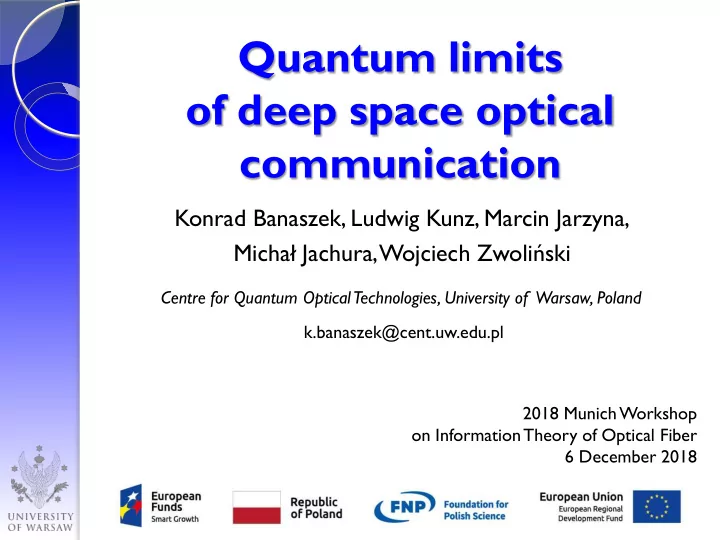

Quantum limits of deep space optical communication Konrad Banaszek, Ludwig Kunz, Marcin Jarzyna, Micha ł Jachura , Wojciech Zwoliński Centre for Quantum Optical Technologies, University of Warsaw, Poland k.banaszek@cent.uw.edu.pl 2018 Munich Workshop on Information Theory of Optical Fiber 6 December 2018
Satellite optical communication Optical vs radio frequency communication Benefits: Access to higher • bandwidths Lower diffraction losses • Reduced regulatory • requirements Challenges: Robustness against • atmospheric conditions Wall-plug efficiency • of onboard transceivers H. Hemmati, A. Biswas, and I. Djordjevic, Pointing and tracking • Deep-Space Optical Communications: Future Perspectives and Applications , Antenna surface quality • Proc. IEEE 99 , 2020 (2011)
Deep-space rf communication links D. Boroson, On achieving high performance optical communications from very deep space, Proc. SPIE 10524 , 105240B (2018)
Deep-space optical communication D. Powell, Lasers boost space communications , Nature 499 , 266 (2013)
Signal strength transmitter power channel transmission and detection efficiency frequency modulation rate B bandwidth carrier frequency slot duration time Average detected number of photons per slot: Planck’s constant
System characteristics Channel transmission: Signal central wavelength B. Moision and W. Farr, IPN Prog. Rep. 42-199, 1-10 (2014 )
Phase-insensitive Gaussian channel Excess Linear noise attenuation Total: Homodyne capacity per slot Shannon-Hartley theorem Heterodyne capacity per slot shot-noise limited detection channel excess noise
Quantum Shannon theory Output ensemble Input ensemble Channel Holevo quantity : for any measurement on the output ensemble where is the von Neumann entropy. For a phase-insensitive Gaussian channel under average power constraint: where V. Giovannetti, R. García-Patrón, N. J. Cerf, A. S. Holevo, Nature Photon. 8 , 796 (2014)
Pure loss channel 5 4 Capacity [bits/slot] 3 heterodyne 2 homodyne 1 0 0 2 4 6 8 10 Average detected photon number
Photon information efficiency Information rate [bits/s]: 14 Photon information efficiency PIE 12 10 ? 8 6 4 homodyne 2 heterodyne 0 10 -4 0.001 0.010 0.100 Average detected photon number
PPM – Pulse Position Modulation Symbols: Geiger-type … direct detection … … pulse optical energy erasure Photocount probability (symbol recovery):
PPM photon information efficiency 14 Photon information efficiency PIE 12 2048 1024 10 512 256 8 128 PPM order 64 6 32 16 4 homodyne 2 heterodyne 0 10 -4 0.001 0.010 0.100 Average detected photon number
PPM PIE asymptotics M. Jarzyna, P. Kuszaj, K. Banaszek, Opt. Express 23 , 3170 (2015) Photocount probability: Approximate analytical expression: Lambert function Photon information efficiency 14 12 for 10 8 Optimal PPM order 6 4 numerical ( ) 2 approx. analytical 0 10 -4 0.001 0.010 0.100 Average detected photon number
Superadditivity of accessible information 14 + + Photon information efficiency + BPSK: − − − − 12 Holevo quantity assumes: 10 Holevo quantity χ 8 preparation of codewords • for BPSK format 6 collective detection of • 4 multiple symbols 2 homodyne 0 10 -4 0.001 0.010 0.100 S. Guha, Phys. Rev. Lett. 106 , 240502 (2011) + + + + + + + + Hadamard codewords + – + – + – + – Linear optical + + – – + + – – circuit + + + – – + + – – + (structured … + + + + – – – – + – receiver) + – + – – + – + + + – – – – + + + – – + – + + –
Scalable structured receiver K. Banaszek and M. Jachura, Proc. IEEE ICSOS 2017, pp. 34-37 T T T T τ 1 0 0 1 0 1 0 1 0 1 0 1 0 1 0 0 0 0 0 1 0 1 0 0 1 1 1 0 0 1 0 1 1 1 0 1 1 1 Pulse position:
Realization K. Banaszek and M. Jachura, Proc. IEEE ICSOS 2017, pp. 34-37 polarization switching τ 1 0 0 1 0 1 0 1 0 1 0 1 0 1 0 0 0 0 0 1 0 1 0 0 1 1 1 0 0 1 0 1 1 1 0 1 1 1 Pulse position:
Phase-polarization patterns K. Banaszek and M. Jachura, Proc. IEEE ICSOS 2017, pp. 34-37 Polarization-dependent delay + rotation by 45 o guard-time symbol guard-time symbol PPM encoding achieved by shifting the entire pattern in time
Atmospheric turbulence J. Jin et al. , Demonstration of analyzers wavefront for multimode photonic time-bin qubits , distorted Phys. Rev. A 97 , 043847 (2018) signal Multimode DPSK receiver Z. Sodnik and M. Sans, Extending EDRS to Laser Communication from Space to Ground , Proc. ICSOS 2012, 13-2
Noisy channel asymptotics 14 Background Photon information efficiency noise power 12 10 8 6 4 2 0 10 -4 0.001 0.010 0.100 Average detected photon number Holevo homodyne heterodyne
Optimized PPM with background noise W. Zwoli ński , M. Jarzyna, and K. Banaszek, Opt. Express 26 , 25827 (2018) complete Background noise decoding simple decoding • multimode background noise yielding Poissonian count statistics • Geiger-type direct detection • unconstrained peak-to-average power ratio (PPM order)
Range dependence W. Zwoli ński , M. Jarzyna, and K. Banaszek, Opt. Express 26 , 25827 (2018) complete decoding simple decoding
High-order modulation formats pulse BPSK frequency position Hadamard shift keying modulation codewords K. Banaszek, M. Jachura, W. Wasilewski, Utilizing time-bandwidth space for efficient deep-space communication , Proc. International Conference on Space Optics 2018, paper P22
Thank you!
Recommend
More recommend